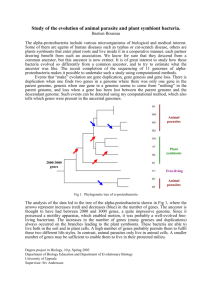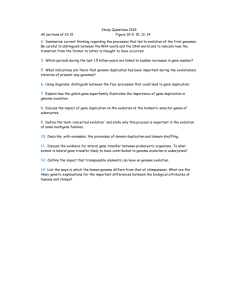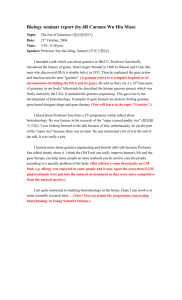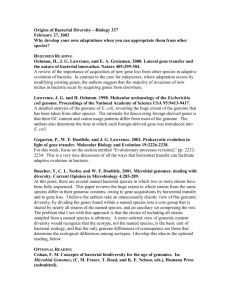Genomes - Fog.ccsf.edu
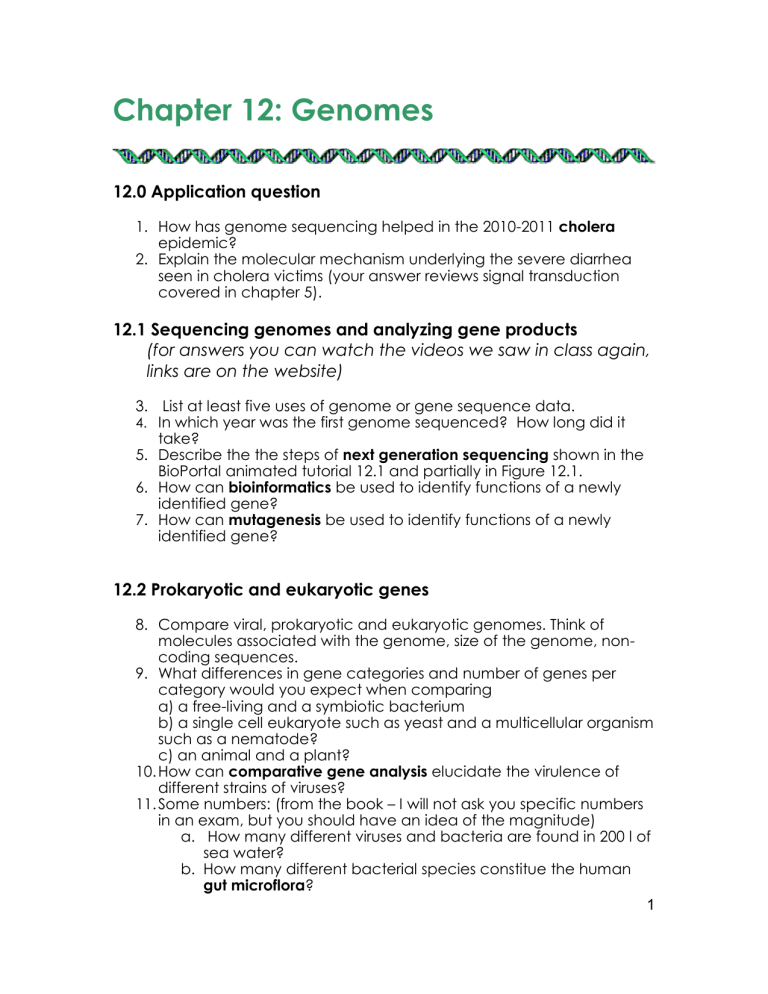
Chapter 12: Genomes
12.0 Application question
1.
How has genome sequencing helped in the 2010-2011 cholera epidemic?
2.
Explain the molecular mechanism underlying the severe diarrhea seen in cholera victims (your answer reviews signal transduction covered in chapter 5).
12.1 Sequencing genomes and analyzing gene products
(for answers you can watch the videos we saw in class again, links are on the website)
3.
List at least five uses of genome or gene sequence data.
4.
In which year was the first genome sequenced? How long did it take?
5.
Describe the the steps of next generation sequencing shown in the
BioPortal animated tutorial 12.1 and partially in Figure 12.1.
6.
How can bioinformatics be used to identify functions of a newly identified gene?
7.
How can mutagenesis be used to identify functions of a newly identified gene?
12.2 Prokaryotic and eukaryotic genes
8.
Compare viral, prokaryotic and eukaryotic genomes. Think of molecules associated with the genome, size of the genome, noncoding sequences.
9.
What differences in gene categories and number of genes per category would you expect when comparing a) a free-living and a symbiotic bacterium b) a single cell eukaryote such as yeast and a multicellular organism such as a nematode? c) an animal and a plant?
10.
How can comparative gene analysis elucidate the virulence of different strains of viruses?
11.
Some numbers: (from the book – I will not ask you specific numbers in an exam, but you should have an idea of the magnitude) a.
How many different viruses and bacteria are found in 200 l of sea water? b.
How many different bacterial species constitue the human
gut microflora?
1
c.
What is the average length of a human gene? d.
What is the average length of a human protein? How can you explain the discrepancy between gene and protein length? e.
How many genes constitute the minimal genome? f.
How many base pairs are in a haploid set of human
chromosomes? g.
How many protein coding genes do humans have? h.
How much of the human genome is non-coding (as of our understanding today)? i.
How much of our genome is made up of repetitive
sequences? j.
What is the percentage of human genes that have homologs all prokaryotes and other eukarotes?
12.4 Human Genome and sequencing application
12.
Explain what evolutionary advantage repetitive gene sequences might have.
13.
What are SNPs – how many, how common are they?
14.
How can SNPs be used to identify genes involved in complex diseases such as diabetes and heart disease (Fig. 12.13)?
15.
What is a haplotype map and how is it superior to a map of individual SNPs?
16.
List the steps used in STR analysis as used in DNA fingerprinting.
17.
A person has a rare allele for an STR (STR-1) that has a frequency in the population of 1 percent (0.01). The same person has allele frequencis for other STRs as follows: STR-2, 0.005; STR-3, 0.01; STR-4,
0.05;STR-5, 0.01. What is the probabiltiy that an individual will have all of these alleles? What does this mean in terms of identifying an individual with this genotype?
2





